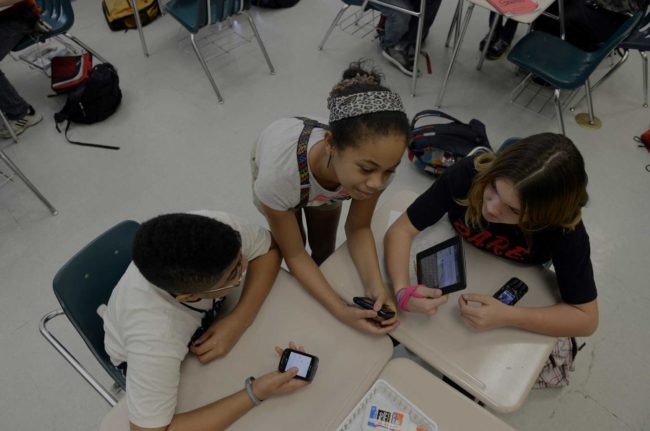01.05.17Technology in School: My View as a Parent

Not sure this is the classroom I want for my kids.
Speaking solely as a parent here, but I am as eager for my children’s schools to insulate them from technology at times–to ask them to read and write and think for long stretches without the distractions and disruptions technology creates–as I am for their schools to expose them to and immerse them in technology.
Their lives are (over-)infused with technology already. Having them read or write without interruption 45 minutes or an hour, say, just a book, just pencil and paper, is a higher priority for me. Sustaining concentration remains critically important to learning, productivity and growth but the difficulty of doing so increases every day.
Not saying ‘no’ to technology–there are clearly productive uses–but arguing for lots of tech-free moments–for human interaction and for making sustained concentration a habit–are at least as important.
What about you? Do you feel similarly? Do you do things to shape your school or classroom (or home) accordingly?

I do agree that all of our lives (not just students) are “over-infused with technology,” though I come to a markedly different conclusion about how to respond to that problem. We have a crisis in education, largely because schools do not create an authentic reflection of the world outside of schools and because teacher-centered learning in a 30:1 analog environment simply is not efficient enough to meet the needs of students. The work I have done with students and teachers in well-managed, technology-rich environments has made it clear that no human teacher without technology can achieve anywhere near the types of results that are possible when using tech effectively.
As for the need to “unplug,” students certainly need time away from devices, but to use that time to have students sit and write with paper and pencil begs the question, why not quill and parchment? Better yet, why not stone tablet and chisel? We tend to see the technology innovations present in our childhood as permanent and immutable, but writing by hand is a dying art. In fact, typing may be gone in a decade as we rely increasingly on voice-recognition.
If students are to unplug, they should be playing, inventing, painting, collbarating, etc, etc. (Even collaboration can be made more effective with the use of technology tools). I have a personal weakness for paperback books, and that is one area where technology has yet to provide a satisfactory alternative, so I couldn’t object to something like reading time.
Ultimately, the use of technology to help us do “old things more efficiently” can help create time in the instructional day to allow us and our students to innovate, play, and enjoy face time with us and with each other. We should take advantage of this extra time, not to train students to use outmoded technologies and the pass standardized tests, but to engage their creativity and allow them to develop skills that they are actually interested in and will actually prove useful in their lives outside of school.
schools are still figuring out how to use technology to support the tremendous cost…Also, I think we continue to overlook using technology to help students be critical thinkers for news stories.
I wholeheartedly agree, Doug–both as a parent and as an educator involved in curriculum and instruction.
In India, private schools management try to overshadow competitors by using technology in classrooms. Students are not ready to write or read books or do home-works / assignments. Teachers are neither equipped with technology nor with knowledge. Without using pen and paper students can’t learn what they should need to learn. Learning is time, energy consuming process and need lots of determination and persistence.
Schools are neither teacher centric nor students-centric . Teaching methodology is one to all with chalk- white board with some ppts/ videos etc. Schools are management- centric.
Tech integration in schools gets a terrible reputation because it is often done poorly. I also acknowledge Doug’s point that there are times where technology does not add value or could even detract from the meaning of a pedagogical activity. That said, I want my kids to be in a school that prepares them to be successful at and have access to the most high fulfillment careers in our country. I cannot think of many such careers that also do not heavily rely on using technology to at minimum augment the particular domain skillset. Is it not also a sign of one’s privilege to be able to pick and choose whether or not to include tech in the classroom? For kids in low income, urban schools, like the Uncommon Network, computer access is just another face of the opportunity gap. Not graduating students with technical proficiency at or above their counterparts in more affluent areas is as big a failure as if the student was below grade level in reading or mathematics. Even when a student matriculates into college with grade level reading / math skills, they are at a huge disadvantage if they cannot create content, research and communicate using technology.
i think those are all good points. i’d prefer intentionality about the wise use of technology (coding!) and intentionality about when and how to restrict it and be low tech. times of restriction do not preclude wise use in other words. thanks for your comment.